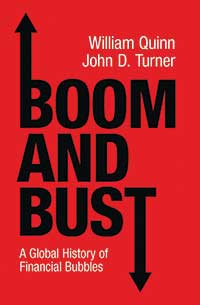Boom and Bust: A Global History of Financial Bubbles

William Quinn and John D. Turner
Cambridge University Press,
Cambridge, UK, 2020,
296 pp., $24.95
From the Mississippi and the South Sea bubbles of the early 1700s to the subprime and Chinese excesses of the 2000s, Boom and Bust: A Global History of Financial Bubbles provides a fascinating guide through a historical journey of speculative financial crises. Building on seminal analyses by Charles P. Kindleberger (Manias, Panics, and Crashes) and John Kenneth Galbraith ( A Short History of Financial Euphoria), authors William Quinn and John Turner present a novel framework they dub the “bubble triangle” for assessing and understanding booms and busts.
They see a financial bubble as a fire, composed of oxygen, fuel, and heat.
The first component of the bubble triangle is the marketability of assets—how easily assets can be purchased and sold—which corresponds to oxygen. The second factor is money and credit—the level of interest rates and the use of financial leverage—which provides the fuel. The third ingredient is speculative behavior—when the purchase of an asset is driven primarily by expectations of a continued rise in the asset price—which is equivalent to heat.
Quinn and Turner identify two triggers that have sparked fire over the past 300 years: technological innovation and government policies.
Loading component...
What are the implications for investors and policymakers? From the perspective of predicting financial follies, all three sides of the triangle are necessary for a bubble to form and for the fire to persist. This framework also allows for the assessment of the severity of the bust: for example, leverage has been a consistent indicator throughout history. Furthermore, it can be used to interpret the increased frequency of bubbles. The globalization of capital markets, deregulation, and technological changes have set the stage for a surge in debt. Will this result in more frequent and more severe boom and bust episodes in the future?
I would have liked the authors to venture more into the policy debate and present specific measures available to policymakers to deal with pernicious bubbles. For example, which side of the triangle should be tackled first? The authors acknowledge that policymakers could reduce money and credit, thus withdrawing some of the fuel from the fire. But they seem to take the view that measures such as tightening monetary policy or leaning against the wind face insurmountable challenges. Bubbles are hard to identify with certainty in real time, and deflating them may cause more harm than good.
But macroprudential policies can be a useful complement to monetary policy, so that policymakers can achieve both traditional inflation and financial stability objectives—even if the macroprudential framework is still evolving, especially for nonbank financial institutions, and even if the available toolkit is admittedly still limited.
In the end, the authors seem to embrace the notion that the best policymakers can do is clean up the mess, while investors need to act as “fire-safety inspectors”—and as students of history, be conscious of the perils of bubble triangles.
Opinions expressed in articles and other materials are those of the authors; they do not necessarily reflect IMF policy.








